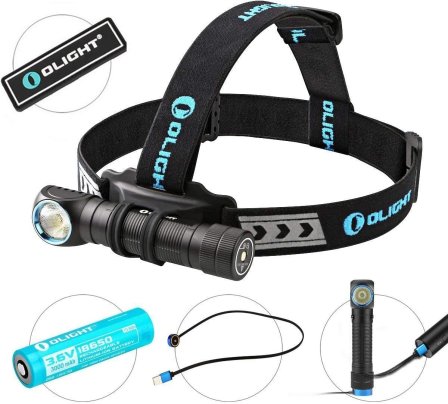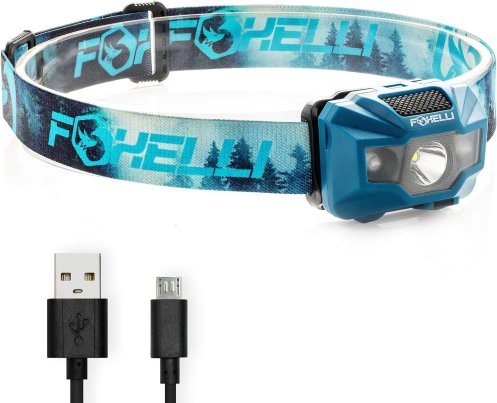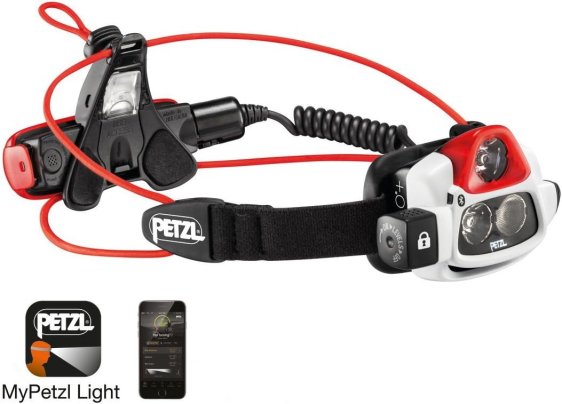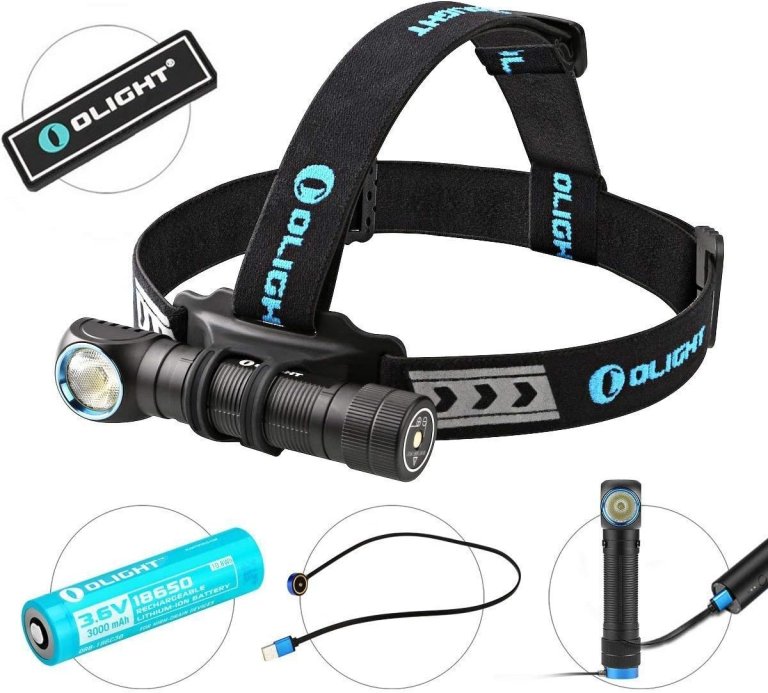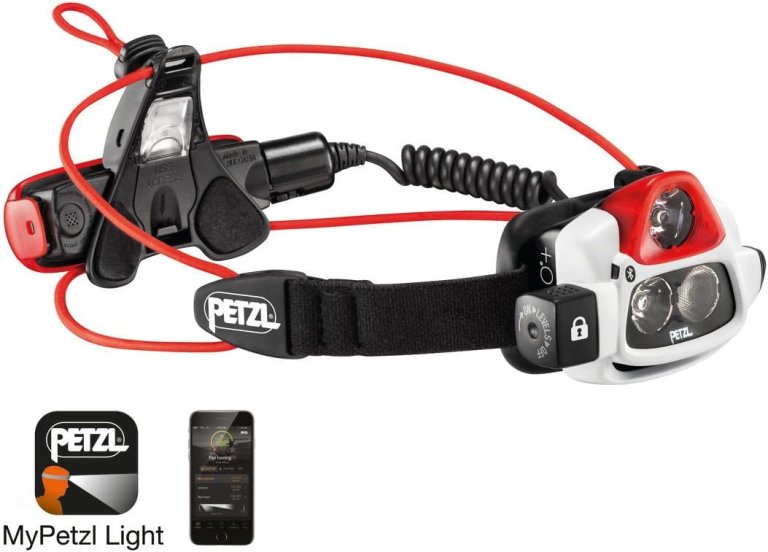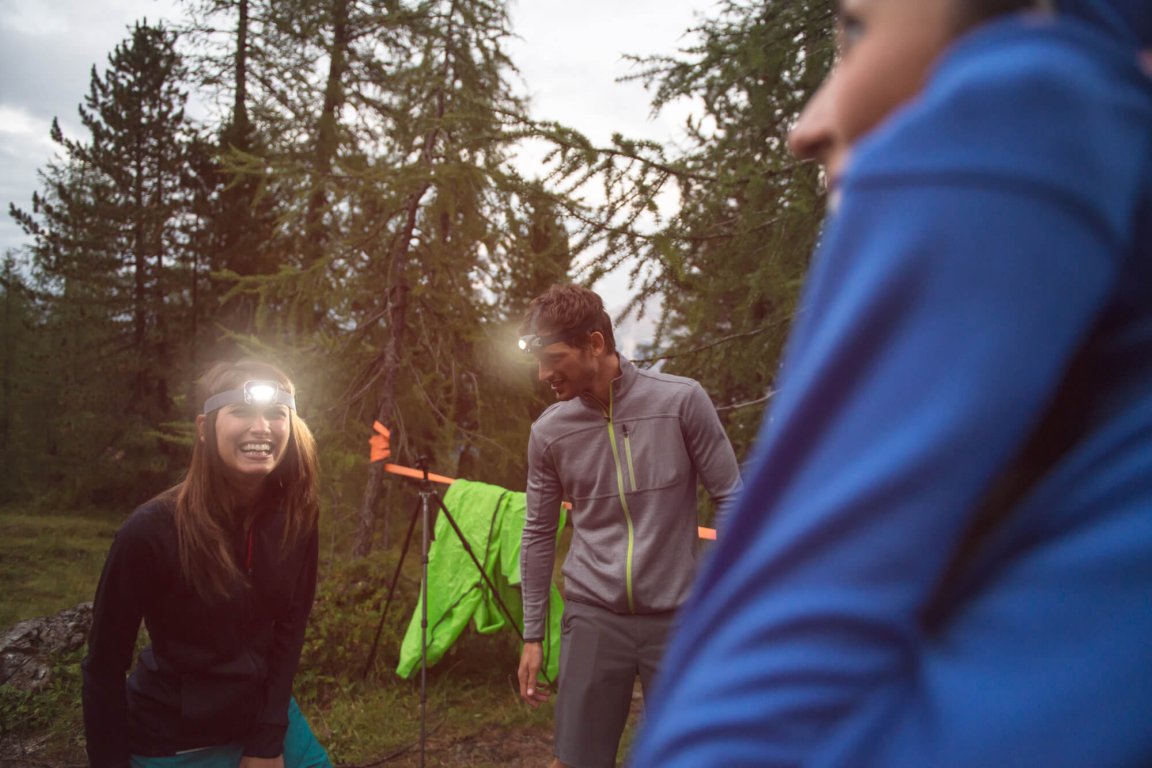
Common amongst hikers and backpackers the world over, headlamps were originally designed for handsfree caving. The potential uses in everyday life are obvious, too. Whether you’re changing a tire in the dark, trail running, or putting up shelves in a deep, dark closet, a high-quality headlamp is a must-have. With such a wide range of makes and models available, we’ve reviewed some of the best headlamps on the market.
Summary List
- Best Overall: OLight H2R Cree LED Rechargeable Headlamp
- Best Value: Foxelli MX200 Rechargeable Headlamp
- Honorable Mention: Petzl NAO+ Headlamp
Types of Rechargeable Headlamps
Single Bulb
While not as common as LED versions due to high battery consumption and low durability, it’s still possible to buy headlamps with a single halogen or krypton bulb. They’re not ideal because of the fragility of the bulb but are great to have around the house in case of an emergency.
Single LED
LEDs are capable of providing high-quality white light with very little power requirements and have become very cheap to manufacture. Single LED headlamps often utilize a magnifying glass placed in front of the bulb to improve light output, which means you can get a lot of light at a low price.
Multi LED Array
Increasing the number of LEDs on a single headlamp will increase light output and brightness, but it won’t necessarily improve the beam distance. Multi LED array headlamps are great for camping because the capability to adjust how many of the total LEDs are used at any one time is a fairly standard feature. They usually come with red or green LEDs for even more light options.
Combined Light Array
A hybrid head torch is one that uses LEDs and a single halogen or krypton bulb for maximum versatility and different lighting requirements. They’re heavier than LED headlights, and the battery life will suffer anytime that you’re using the single bulb.
Best Rechargeable Headlamps: Reviews & Recommendations
Best Overall
OLight H2R Cree LED Rechargeable Headlamp
Check Latest PriceBest Value
Foxelli MX200 Rechargeable Headlamp
Check Latest PriceHonorable Mention
Petzl NAO+ Headlamp
Check Latest PriceOur Verdict on the Best Rechargeable Headlamps
After thorough research, we recommend the OLight H2R Cree LED Rechargeable Headlamp as our best overall pick. It is versatile, unbelievably bright, and fully adjustable.
If you want something a little more budget-friendly and don’t need super bright light, the waterproof, 180-lumen Foxelli USB Rechargeable Headlamp Flashlight is our best value pick.
Benefits of Rechargeable Headlamps
- Convenient. Having a light source that doesn’t tie up your hands is infinitely useful. Having a rechargeable headlamp means never again having to buy new batteries, which is even more convenient.
- Cost-effective. Rechargeable head torches might be a little more expensive up front, but you only need to charge them a couple of times before you start seeing savings from not having to buy batteries over and over again.
- Eco-friendly. Not having to buy batteries means you also don’t have to dispose of batteries, and any reduction in waste or single-use products is a massive benefit for the environment.
Rechargeable Headlamp Pricing
- Budget Range (under $50): Expect a lot of own-brand headlamps and some from top brands with basic features and up to around 350 lumens. These are perfect for hobbyists, emergencies, camping, and sports that don’t require precise lighting.
- Medium Range ($50-$200): Unless you need professional-level lighting conditions, a mid-range headlamp should be more than sufficient for 95 percent of users, with all the features you could want plus guaranteed quality from brands you recognize.
- Premium Range ($200 and up): If you rely on a headlamp for safety or need very specific features, you’ll likely be looking in the premium range. You can get a serious amount of light over extended periods if you’re willing to hand over the cash.
Key Features
Lumens
The light output of your headlamp is probably the most important feature to consider. Ask yourself how much light you need and for how long you’ll need to maintain that light. Daylight, for example, is anywhere between 100 and 300 lumens, 2,000 lumens will temporarily blind intruders, and 20 to 50 lumens is more than sufficient for finding your tent on the way back from a midnight toilet trip.
Battery
If you’re choosing a rechargeable headlamp specifically, you need to know how long a full charge will last and how feasible it is to recharge on the go. Do you need a dual power source, which would include backup battery power, and, if so, should you also carry spare batteries?
Red Light Mode
Using red light as opposed to standard white light has a number of benefits. Red light mode will give you enough illumination to see what you’re doing—even to read by —but it won’t blind your fellow campers if you’re wandering around the site or chatting by the campfire. Lower brightness also means lower power draw, so it’s also a good way to conserve battery between charges.
Adjustability
Is your headlamp simply on at full brightness or off, with no option for anything in between, or does it offer brightness adjustability? Being able to adjust the light output is handy if you’re going to be using your headlamp in a range of situations, especially if you have one with high maximum lumens. Maintaining bright light uses a lot of power and isn’t always necessary.
Beam Type
Your head torch will either have a wide flood beam, a narrow spot beam, or an adjustable combination of the two. Flood beams are ideal for general use, like camping and reading, and even up-close repairs because they provide a pool of unfocused light, but beam distance or focused light is often limited. Narrow spotlights, however, provide tightly focused beams that are great at illuminating over a distance and are much better for activities such as trail running. An adjustable beam obviously offers the most versatility and usage options.
Other Considerations
- Weight. If you’re going to be wearing the headlamp for extended periods, it’s probably a good idea to check how much it weighs. Extra weight can unbalance you if you’re moving at high speeds or over uneven ground, and, besides that, nobody wants to carry unnecessary extra weight on long hikes or challenging runs.
- Power Indicator. While the benefits of rechargeable headlamps over battery-powered ones are obvious, the convenience of not needing to carry spare batteries can be dampened if you don’t know when it needs recharging. A power indicator gets rid of the uncertainty and ensures you’re always well-prepared.
- Headband. Most headlamps will have a single one-size, adjustable, and elasticated headband to keep things in place. Whether this is sufficient will depend on personal comfort and what you’re going to be doing while wearing the headlamp. Second headbands (over the top of the head) are worth considering if you want a little more stability and security.
Tips
- When buying a headlamp, consider the available powering options. Most lights are powered by rechargeable lithium batteries, while some have dual-powering capability, meaning they can use either a rechargeable battery or a disposable alkaline battery. A dual-powered light is useful when your power bank dies out.
- Consider the light with a versatile beam pattern. A flood beam illuminates a wide area but a short distance, while a spot beam illuminates a small area but a longer distance. It is advisable to get a light that can switch beams to suit different requirements.
- Make sure the headlamp you buy is waterproof to withstand rain and snow if you plan to use it in these conditions. It should also be able to tilt from its strap to help position your beam where you want it. A good headlamp is also lightweight for portability.
FAQs
A: A headlamp illuminates your working area without getting in the way. It comes with a strap to fit on your forehead, freeing your hands to do other things.
A: Yes, lumens really matter when choosing a headlamp. They indicate the amount of light the light can produce. A low lumen count means dim light, while a high lumen count means the light is much brighter.
A: The number of lumens you need in a headlamp depends on the purpose of the light. If your headlamp is for illuminating trails when running, about 100 lumens would be enough. If your light is for hunting or some other work that requires a high degree of illumination, your headlamp should have at least 300 lumens.
